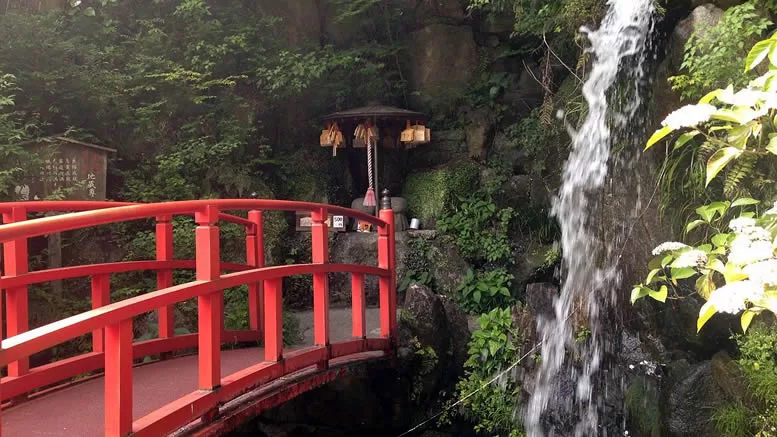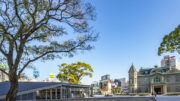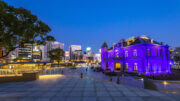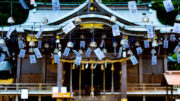 Nestled in the tranquil hills of Sasaguri, just outside Fukuoka City, Nanzoin Temple is a hidden gem renowned for its massive reclining Buddha statue, one of the largest bronze statues in the world. This serene temple complex, part of the Sasaguri Pilgrimage route, offers a peaceful retreat from the hustle and bustle of urban life, drawing visitors with its spiritual ambiance, lush surroundings, and awe-inspiring landmarks.
Nestled in the tranquil hills of Sasaguri, just outside Fukuoka City, Nanzoin Temple is a hidden gem renowned for its massive reclining Buddha statue, one of the largest bronze statues in the world. This serene temple complex, part of the Sasaguri Pilgrimage route, offers a peaceful retreat from the hustle and bustle of urban life, drawing visitors with its spiritual ambiance, lush surroundings, and awe-inspiring landmarks.
The Great Reclining Buddha
The centerpiece of Nanzoin Temple is the Nehanzo, a reclining Buddha statue that measures 41 meters in length, 11 meters in height, and weighs an impressive 300 tons. This monumental statue, often referred to as the Reclining Buddha of Sasaguri, was completed in 1995 and is a symbol of Buddha’s peaceful passing into Nirvana. The statue’s serene expression and the intricate detail of its bronze surface make it a remarkable sight, leaving a lasting impression on all who visit.
Visitors can walk around the statue, which is elevated on a platform surrounded by beautiful gardens and prayer flags. The area beneath the statue is also of spiritual significance, as it contains a sacred relic from the historical Buddha, donated by Myanmar. Pilgrims and visitors often come to offer prayers and pay their respects, creating a contemplative and reverent atmosphere around the statue.
Exploring the Temple Grounds
Beyond the Reclining Buddha, Nanzoin Temple is a sprawling complex with numerous smaller shrines, statues, and paths that wind through the forested hills. The temple is part of the Sasaguri Pilgrimage, a 44-kilometer route that connects 88 sacred sites, similar to the famous Shikoku Pilgrimage. Many of these sites are located within the Nanzoin grounds, making it an important stop for pilgrims and spiritual seekers.
As you explore the temple grounds, you’ll encounter a variety of statues, including a large stone Jizo (guardian deity of children) and a seven-meter-tall statue of the Medicine Buddha, who is believed to bring health and healing. The temple also features several smaller shrines dedicated to different deities, each with its unique charm and significance.
One of the most enchanting aspects of Nanzoin is its integration with nature. The temple grounds are lush with greenery, particularly in the spring and autumn when the surrounding foliage creates a vibrant display of colors. Stone steps and paths lead visitors through the forest, past small waterfalls, and over charming bridges, creating a sense of serenity and connection to the natural world.
Spiritual Significance and Local Traditions
Nanzoin Temple is deeply rooted in the local spiritual traditions and is a place of pilgrimage for many devotees. The temple’s history dates back over 1,300 years, and it has long been associated with healing and good fortune. According to local legend, the temple’s founding monk, Kobo Daishi, discovered a source of miraculous healing water on the site, which led to the establishment of the temple as a place of worship.
Today, Nanzoin continues to be a center for spiritual practice and pilgrimage. Visitors often participate in rituals such as the washing of statues or the tying of prayer strips, which are believed to bring blessings and protection. The temple’s annual events, including ceremonies and festivals, attract large numbers of pilgrims and tourists, adding to the vibrant spiritual life of the area.
Access Information
Nanzoin Temple is easily accessible from Fukuoka City, making it a perfect day trip for those seeking a peaceful and spiritually enriching experience:
- From Hakata Station: Take the JR Fukuhoku Yutaka Line to Kidonanzoin-mae Station, a journey of about 25 minutes. From the station, the temple is a short 5-minute walk.
- By Car: Nanzoin Temple is about a 30-minute drive from central Fukuoka. Parking is available near the temple, but spaces can be limited, especially during peak visiting times.
- By Bus: Local buses also run from nearby towns to the temple, with stops at Kidonanzoin-mae Station.




